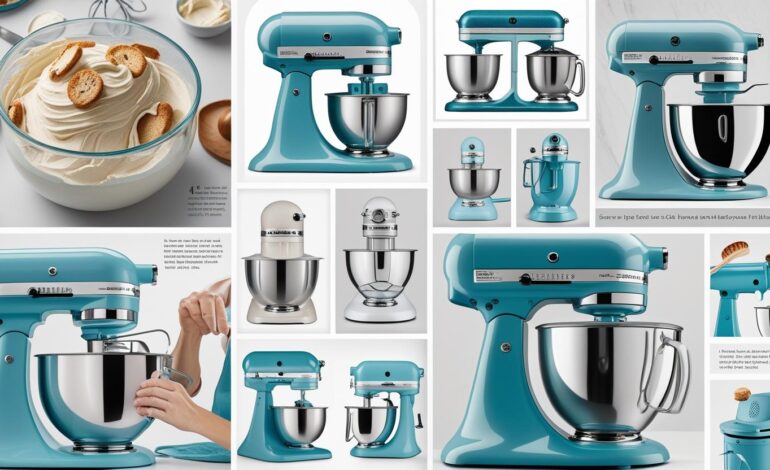The Ultimate Guide to Stand Mixers: Choosing the Right One for Your Kitchen

Stand mixers have become a staple in modern kitchens, transforming the way we prepare our favorite dishes. Whether you’re an avid baker or a casual cook, these powerful machines can elevate your culinary creations to new heights. But with so many styles and features available, navigating the world of stand mixers can feel overwhelming.
Understanding the different types of stand mixers is crucial for making an informed choice that suits your cooking needs. From whipping up fluffy meringues to kneading dough effortlessly, the right mixer will not only save you time but also enhance your overall kitchen efficiency. Let’s dive into everything you need to know about stand mixers and discover how they can revolutionize your cooking experience!
Benefits of Using a Stand Mixer in the Kitchen
Stand mixers are a game-changer in the kitchen. They save time and energy, making baking tasks feel effortless. Instead of mixing by hand, you can focus on other aspects of your recipe.
The consistent results produced by a stand mixer are hard to beat. Whether you’re whipping cream or kneading dough, these machines ensure even mixing every time. This accuracy is essential for achieving that perfect cake or bread texture.
Another benefit lies in versatility. With various attachments available, a stand mixer can handle pasta-making or grinding meat with ease. It opens up new culinary possibilities without requiring multiple appliances.
Types of Stand Mixers:
When exploring the types of stand mixers, two main designs surface: tilt-head and bowl-lift. Each brings its own advantages to the kitchen.
Tilt-head stand mixers are incredibly popular for their ease of use. With a simple lift of the head, you can access your bowl effortlessly. This design is perfect for home bakers who frequently switch between tasks or need to add ingredients during mixing.
On the other hand, bowl-lift stand mixers offer enhanced stability. They feature a more robust construction that supports heavy doughs with ease. The lifting mechanism allows for greater clearance and is often preferred by professionals or avid bakers tackling large batches.
Tilt-Head Stand Mixers
Tilt-head stand mixers are a favorite among home bakers and cooking enthusiasts. Their design is both functional and user-friendly, allowing you to easily access the mixing bowl.
With a simple tilt of the head, you can add ingredients effortlessly or scrape down the sides without any hassle. This feature makes it particularly convenient for multitasking in the kitchen.
Most tilt-head models come equipped with powerful motors, ensuring they handle doughs and batters of various thicknesses smoothly. You’ll find that they perform well across a range of recipes—from fluffy meringues to dense bread dough.
Bowl-Lift Stand Mixers
Bowl-lift stand mixers are an excellent choice for serious bakers. They feature a robust design that allows the mixing bowl to be raised and lowered, providing stability during heavy-duty tasks.
This type of mixer typically has a more powerful motor than its tilt-head counterpart. As a result, it can handle thick doughs like bread or pizza with ease. The sturdy construction also minimizes vibrations, making it ideal for rigorous mixing jobs.
The bowl-lift mechanism is particularly beneficial when working with large batches. You can easily secure the bowl in place without worrying about spills or messes.
Features and Functions to Consider when Choosing a Stand Mixer:
When selecting a stand mixer, motor power is crucial. A robust motor ensures efficient mixing and kneading, especially for dense doughs. Look for at least 300 watts to handle various tasks effortlessly.
Speed settings add versatility to your mixing experience. Multiple speeds allow you to start slow and gradually increase as needed. This feature is particularly useful for incorporating dry ingredients without creating a mess.
Bowl size and capacity should match your cooking needs. If you often bake in large batches or prepare meals for gatherings, consider mixers with larger bowls that hold up to 7 quarts or more. For smaller households, a compact option may suffice.
Motor Power
When choosing a stand mixer, motor power plays a crucial role. A powerful motor enhances performance and efficiency. It can handle tough doughs and thick batters with ease.
Typically measured in watts, the strength of the motor determines how well it performs under different conditions. For occasional bakers, a lower wattage may suffice. However, frequent users or those tackling challenging recipes will benefit from a more robust option.
Higher wattage often translates to better durability and longevity. It allows for consistent mixing without straining the appliance over time.
Speed Settings
Speed settings are a crucial aspect of stand mixers that enhance their versatility. Different recipes require varying levels of mixing, from gentle folding to vigorous whipping. A mixer with multiple speed options allows you to tailor the power to your specific needs.
Most stand mixers offer at least three speeds: low, medium, and high. The low setting is perfect for gradually incorporating dry ingredients without creating a cloud of flour. Medium speed works well for most common tasks like creaming butter and sugar or beating eggs.
High-speed settings come into play when you need more thorough mixing or aeration, such as whipping cream or egg whites. Some advanced models even feature slow-start technology that prevents splatter while ramping up the power.
Bowl Size and Capacity
When selecting a stand mixer, bowl size and capacity play a crucial role. A larger bowl can accommodate bigger batches of dough or batter, making it ideal for those who frequently bake in bulk. This is particularly advantageous for hosting events or preparing family meals.
On the other hand, compact bowls are perfect for everyday tasks and small kitchens. They save space while still providing enough room for standard recipes.
Consider your cooking habits when evaluating bowl capacity. If you often experiment with different recipes or want to make multiple items at once, opt for a generous-sized bowl.
Innovative Attachments for Multi-Purpose Use:
Stand mixers are more than just a baking companion. They can transform into versatile kitchen powerhouses with the right attachments.
The pasta maker attachment is a game changer for those who love fresh ingredients. It lets you roll out dough and cut it into different shapes, making homemade pasta effortless. Imagine crafting fettuccine or lasagna sheets from scratch—it’s an experience that elevates any dish.
Another standout accessory is the meat grinder attachment. This tool provides complete control over your ground meats, ensuring freshness and quality. Whether you’re preparing burgers or sausages, grinding your own meat opens up a world of culinary possibilities.
Pasta Maker Attachment
The pasta maker attachment transforms your stand mixer into an Italian kitchen powerhouse. With it, you can create fresh pasta right at home, elevating your culinary game.
This handy tool rolls out dough evenly and cuts it into various shapes. Whether you’re craving fettuccine, lasagna sheets, or tagliatelle, this attachment does the trick effortlessly.
Meat Grinder Attachment
The meat grinder attachment transforms your stand mixer into a versatile kitchen powerhouse. With this tool, you can create ground meats with ease and precision.
Imagine crafting fresh burger patties or meatballs using quality cuts. You control the ingredients and flavors, ensuring every bite is tailored to your taste.
This attachment typically includes various grinding plates, allowing for different textures—fine for sausages or coarse for chili con carne. The convenience of making homemade sausage can’t be overstated; it’s both satisfying and healthier than store-bought options.
Comparison of Top Brands and Models:
When exploring the types of stand mixers, several top brands frequently dominate discussions. KitchenAid remains a household name, known for its durability and versatility. Their Artisan series offers a variety of colors and attachments, making it ideal for home bakers.
Bosch is another strong contender, particularly favored by those who prioritize power. The Bosch Universal Plus boasts a large capacity and unique design that allows for efficient mixing without splatter.
For chefs seeking commercial-grade performance at home, Cuisinart’s Precision Master stands out with its robust motor and sleek finish. It’s perfect for tackling heavy doughs or complex recipes.
Conclusion
When considering types of stand mixers for your kitchen, it’s essential to weigh the benefits and features that suit your cooking style. A reliable stand mixer not only enhances efficiency but also elevates culinary creativity. Whether you opt for a tilt-head or bowl-lift model, each type offers unique advantages tailored to different needs.







